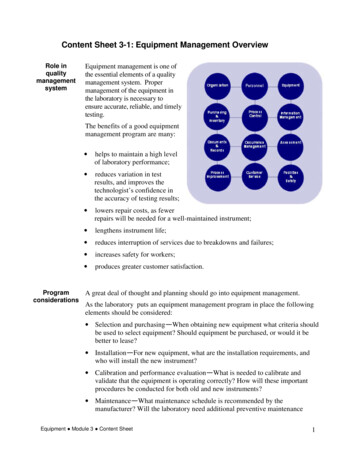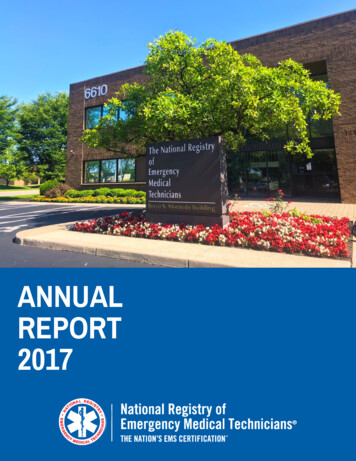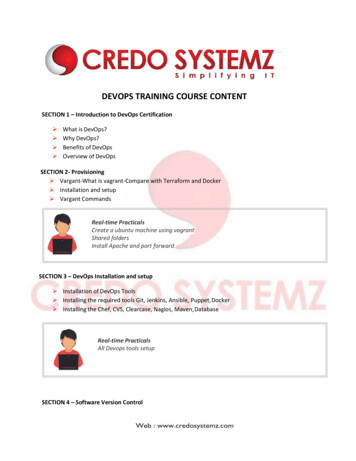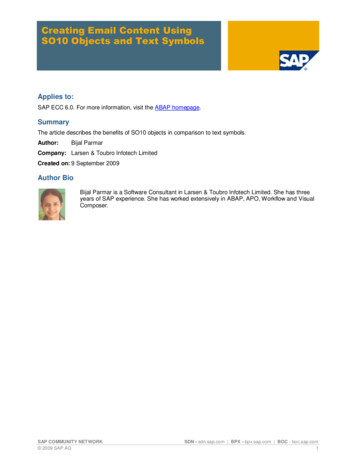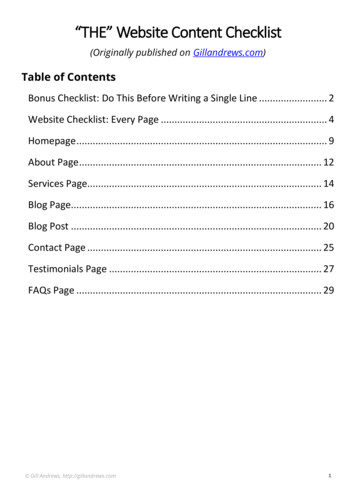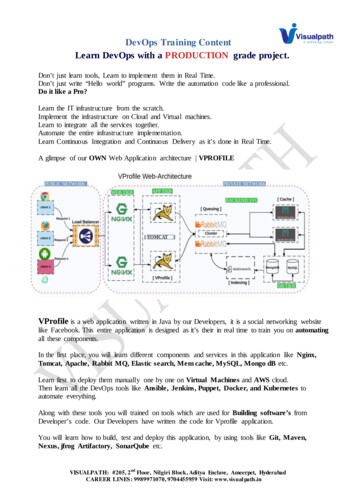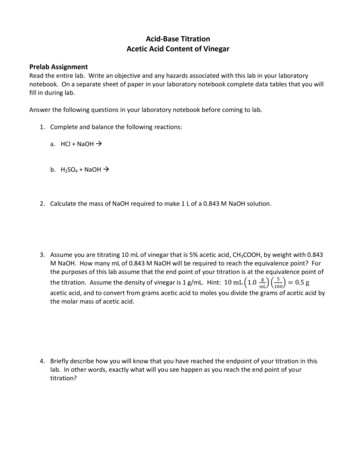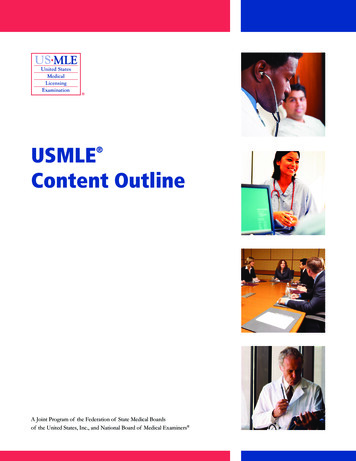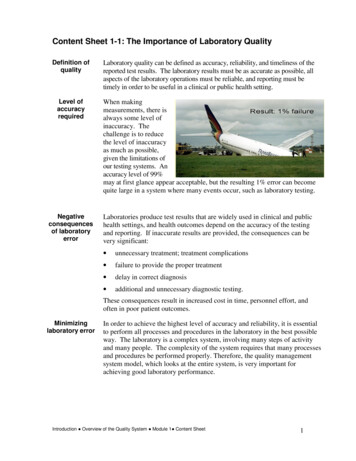
Transcription
Content Sheet 1-1: The Importance of Laboratory QualityDefinition ofqualityLaboratory quality can be defined as accuracy, reliability, and timeliness of thereported test results. The laboratory results must be as accurate as possible, allaspects of the laboratory operations must be reliable, and reporting must betimely in order to be useful in a clinical or public health setting.Level ofaccuracyrequiredWhen makingmeasurements, there isalways some level ofinaccuracy. Thechallenge is to reducethe level of inaccuracyas much as possible,given the limitations ofour testing systems. Anaccuracy level of 99%may at first glance appear acceptable, but the resulting 1% error can becomequite large in a system where many events occur, such as laboratory testing.Negativeconsequencesof laboratoryerrorLaboratories produce test results that are widely used in clinical and publichealth settings, and health outcomes depend on the accuracy of the testingand reporting. If inaccurate results are provided, the consequences can bevery significant: unnecessary treatment; treatment complications failure to provide the proper treatment delay in correct diagnosis additional and unnecessary diagnostic testing.These consequences result in increased cost in time, personnel effort, andoften in poor patient outcomes.Minimizinglaboratory errorIn order to achieve the highest level of accuracy and reliability, it is essentialto perform all processes and procedures in the laboratory in the best possibleway. The laboratory is a complex system, involving many steps of activityand many people. The complexity of the system requires that many processesand procedures be performed properly. Therefore, the quality managementsystem model, which looks at the entire system, is very important forachieving good laboratory performance.Introduction Overview of the Quality System Module 1 Content Sheet1
Content Sheet 1-2: Overview of the Quality Management SystemDefinition ofqualitymanagementsystemA quality management system can be defined as “coordinated activitiesto direct and control an organization with regard to quality.” Thisdefinition is used by the International Organization for Standardization(ISO), and by the Clinical and Laboratory Standards Institute (CLSI).Both groups are internationally recognized laboratory standardsorganizations, and will be discussed later in the lectures.In a quality management system, all aspects of the laboratory operation,including the organizational structure, processes, and procedures, needto be addressed to assure quality.Complexity oflaboratoryprocessesThere are many procedures and processes that are performed in thelaboratory and each of these must be carried out correctly in order toassure accuracyand reliability oftesting. An errorin any part of thecycle can producea poor laboratoryresult. A methodof detecting errorsat each phase oftesting is needed ifquality is to beassured.ISO standards group laboratory processes into pre-examination,examination, and post-examination categories. Comparable terms incurrent laboratory use include: pre-analytic, analytic, and post-analyticprocesses; or pre-test, test, and post-test processes.Path of WorkflowThe entire set of operations that occur in testing is called the Path ofWorkflow. The Path of Workflow begins with the patient and ends inreporting and results interpretation.The concept of the Path of Workflow is a key to the quality model or thequality management system, and must be considered when developingquality practices. For example, a sample that is damaged or altered as aresult of improper collection or transport cannot provide a reliableIntroduction Overview of the Quality System Module 1 Content Sheet2
result. A medical report that is delayed or lost, or poorly written, cannegate all the effort of performing the test well.QualityThe complexity of the laboratory system requires that many factorsmanagementmust be addressed to assure quality in the laboratory. Some of thesesystem addresses factors include:all processes the laboratory environment quality control procedures communications record-keeping competent and knowledgeable staff good quality reagents and equipment.Introduction Overview of the Quality System Module 1 Content Sheet3
Content Sheet 1-3: The Quality Management System ModelOverview of thequalitymanagementsystem modelWhen all of the laboratory proceduresand processes are organized into anunderstandable and workablestructure, the opportunity to ensurethat all are appropriately managed isincreased. The quality model usedhere organizes all of the laboratoryactivities into twelve quality systemessentials. These quality systemessentials are a set of coordinatedactivities that serve as buildingblocks for quality management.Each must be addressed if overalllaboratory quality improvement isto be achieved. This qualitymanagement system model was developed by CLSI1, and is fullycompatible with ISO standards.2,3Assuring accuracy and reliability throughout the Path of Workflow dependson good management of all of the quality essentials.OrganizationIn order to have a functioning quality management system, the structure andmanagement of the laboratory must be organized so that quality policies canbe established and implemented. There must be a strong, supportingorganizational structure—management commitment is crucial; and there mustbe a mechanism for implementation and monitoring.PersonnelThe most important laboratory resource is a competent, motivated staff. Thequality management system addresses many elements of personnelmanagement and oversight, and reminds us of the importance ofencouragement and motivation.EquipmentMany kinds of equipment are used in the laboratory, and each piece ofequipment must be functioning properly. Choosing the right equipment,installing it correctly, assuring that new equipment works properly, andhaving a system for maintenance are all part of the equipment managementprogram in a quality management system.1CLSI/NCCLS. A Quality Management System Model for Health Care; Approved Guideline—SecondEdition. CLSI/NCCLS document HS1-A2. Wayne, PA: NCCLS; 2004.2ISO 15189:2007. Medical laboratories–Particular requirements for quality and competence. Geneva:International Organization for Standardization.3ISO 9001:2000. Quality management systems–requirements. Geneva: International Organization forStandardization.Introduction Overview of the Quality System Module 1 Content Sheet4
Purchasing andInventoryThe management of reagents and supplies in the laboratory is often achallenging task. However, proper management of purchasing and inventorycan produce cost savings in addition to assuring supplies and reagents areavailable when needed. The procedures that are a part of management ofpurchasing and inventory are designed to assure that all reagents and suppliesare of good quality, and that they are used and stored in a manner thatpreserves integrity and reliability.Process ControlProcess Control is comprised of several factors that are important in assuringthe quality of the laboratory testing processes. These factors include qualitycontrol for testing, appropriate management of the sample, includingcollection and handling, and method verification and validation.The elements of process control are very familiar to laboratorians; qualitycontrol was one of the first quality practices to be used in the laboratory andcontinues to play a vital role in assuring accuracy of testing.InformationManagementThe product of the laboratory is information, primarily in the form of testreporting. Information (data) needs to be carefully managed to assureaccuracy and confidentiality, as well as accessibility to the laboratory staffand to the health care providers. Information may be managed and conveyedwith either paper systems or with computers; both will be discussed in thesection on Information Management.Documents andRecordsMany of the twelve quality system essentials overlap each other. A goodexample is the close relationship between Documents and Records, andInformation Management. Documents are needed in the laboratory to informhow to do things, and laboratories always have many documents. Recordsmust be meticulously maintained, so as to be accurate and accessible.OccurrenceManagementAn “occurrence” is an error or an event that should not have happened. Asystem is needed to detect these problems or occurrences, to handle themproperly, and to learn from mistakes and take action so that they do nothappen again.AssessmentThe process of assessment is a tool for examining laboratory performance andcomparing it to standards or benchmarks, or the performance of otherlaboratories. Assessment may be internal, or performed within the laboratoryusing its own staff, or it may be external, conducted by a group or agencyoutside the laboratory.Laboratory quality standards are an important part of the assessment process,serving as benchmarks for the laboratory.Introduction Overview of the Quality System Module 1 Content Sheet5
ProcessImprovementThe primary goal in a quality management system is continuous improvementof the laboratory processes, and this must be done in a systematic manner.There are a number of tools that are useful for process improvement.CustomerServiceThe concept of customer service has often been overlooked in laboratorypractice. However, it is important to note that the laboratory is a serviceorganization; therefore, it is essential that clients of the laboratory receivewhat they need. The laboratory should understand who the customers are,and should assess their needs and use customer feedback for makingimprovements.Facilities andSafetyQualitymanagementsystem modelMany factors must be a part of the quality management of facilities andsafety. These include: Security—which is the process of preventing unwanted risks and hazardsfrom entering the laboratory space. Containment—which seeks to minimize risks and prevent hazards fromleaving the laboratory space and causing harm to the community. Safety—which includes policies and procedures to prevent harm toworkers, visitors, and the community. Ergonomics—which addresses facility and equipment adaptation to allowsafe and healthy working conditions at the laboratory site.In the quality management system model all twelve QSEs must be addressedto assure accurate,reliable, and timelylaboratory results, and tohave quality throughoutthe laboratoryoperations. It isimportant to note thatthe 12 QSEs may beimplemented in theorder that best suits thelaboratory. Approachesto implementation willvary with the local situation.Laboratories not implementing a good quality management system areguaranteed that there will be many errors and problems occurring that may goundetected. Implementing such a quality management system may notguarantee an error-free laboratory, but it does yield a high quality laboratorythat detects errors and prevents them from recurring.Introduction Overview of the Quality System Module 1 Content Sheet6
Content Sheet 1- 4: History of Laboratory Quality ManagementDefinition ofqualitymanagementISO 9000 defines quality management as “coordinated activities to directand control an organization with regard to quality.” This is intimately relatedto the definition of a quality system—“organizational structure, resources,processes and procedures needed to implement quality management.”Quality management concepts in use today had their onset in the 20thcentury, and are primarily an outgrowth of manufacturing and shopprocesses.Principalinnovatorsand theircontributionsOne of the earliest concepts of the quality management movement was thatof quality control of the product. Shewhart developed a method for statisticalprocess control in the 1920s, forming the basis for our quality controlprocedures in the laboratory. Quality control methods were not applied in thelaboratory until the1940s. Other criticalthinkers andinnovators, includingArman Feigenbaum,Kaoru Ishikawa, andGenichi Taguchi,added to theconcepts. The mostrecent of importanceto the laboratory isGalvin’s work onmicro-scale error reduction.Quality Management is not new.Introduction Overview of the Quality System Module 1 Content Sheet7
Content Sheet 1-5: International Laboratory StandardsNeed forinternationallaboratorystandardsA part of quality management is assessment, measuring performance against astandard or benchmark. The new concept of quality management required thatstandards be set, and again industry has been in the g a set of standards established by the U.S. military for the manufacture andproduction of equipment, the International Organization for Standardizationestablished standards for industrial manufacturing; we know these standards as ISO.ISOCLSIThe ISO 9000 documents provide guidance for quality in manufacturing and serviceindustries, and can be broadly applied to many other kinds of organizations. ISO9001:2000 addresses general quality management system requirements and apply tolaboratories. There are two ISO standards that are specific to laboratories: ISO 15189:2007. Medical laboratories–Particular requirements for quality andcompetence. Geneva: International Organization for Standardization. ISO/IEC 17025:2005. General requirements for the competence of testing andcalibration laboratories. Geneva: International Organization for Standardization.Another important international standards organization for laboratories is the Clinicaland Laboratory Standards Institute, or CLSI, formerly known as the NationalCommittee for Clinical Laboratory Standards (NCCLS). CLSI uses a consensusprocess involving many stakeholders for developing standards. CLSI developed thequality management system model used in these training materials. This model isbased on twelve quality system essentials (QSE), and is fully compatible with ISOlaboratory standards.CLSI has two documents that are very important in the clinical laboratory. CLSI/NCCLS. A Quality Management System Model for Health Care; ApprovedGuideline—Second Edition. CLSI/NCCLS document HS1-A2. Wayne, PA:NCCLS; 2004. CLSI/NCCLS. Application of a Quality Management System Model for LaboratoryServices; Approved Guideline—Third Edition. CLSI/NCCLS document GP26-A3.Wayne, PA: NCCLS; 2004.This training toolkit is based on the CLSI quality management system model and theISO 15189 standard.OtherstandardsThere are many other standards organizations, and many examples of laboratorystandards. Some countries have established national laboratory quality standards thatapply specifically to laboratories within the country. Some laboratory standards applyonly to specific areas in the laboratory or only to specific tests. The World HealthOrganization has established standards for some specific programs and areas.Introduction Overview of the Quality System Module 1 Content Sheet8
Content Sheet 1-6: SummaryQualitymanagementKey messagesQuality management is not new; it grew from the good works of innovators whodefined quality over a span of 80 years. Quality management is as applicable for themedical laboratory as it is for manufacturing and industry. A laboratory is a complex system and all aspects must function properly to achievequality. Approaches to implementation will vary with the local situation. Start with changes that can be easily accomplished and have the biggest impact. Implement in stepwise process but ultimately, all quality essentials must beaddressed.Introduction Overview of the Quality System Module 1 Content Sheet9
organizational structure —management commitment is crucial; and there must be a mechanism for implementation and monitoring. Personnel The most important laboratory resource is a competent, motivated staff. The quality management system addresses many elements of personnel management
